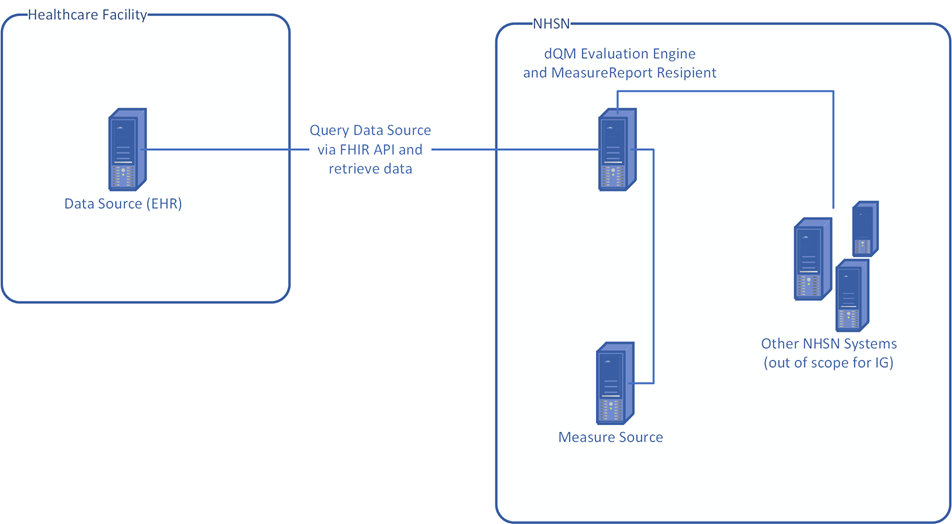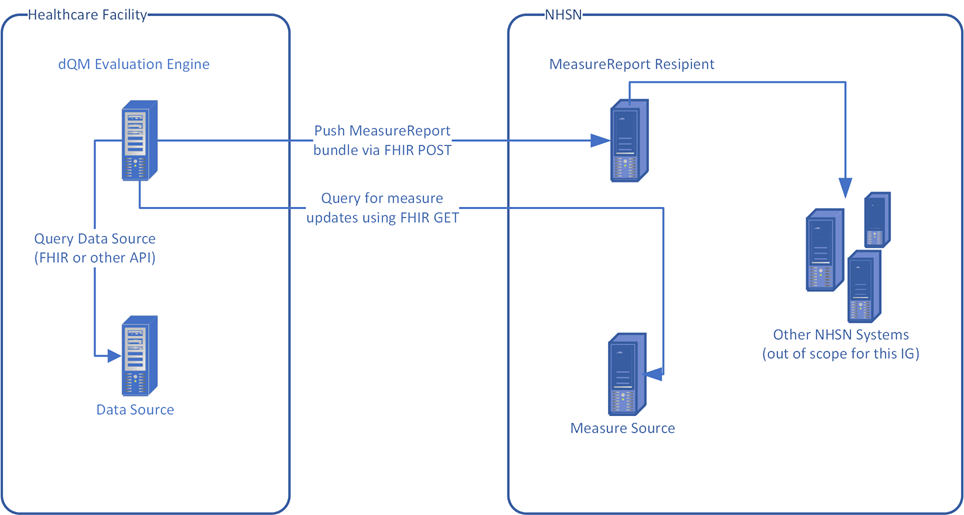National Healthcare Safety Network (NHSN) Digital Quality Measure (dQM) Reporting Implementation Guide, published by HL7 International / Public Health. This guide is not an authorized publication; it is the continuous build for version 1.0.0 built by the FHIR (HL7® FHIR® Standard) CI Build. This version is based on the current content of https://github.com/HL7/nhsn-dqm/ and changes regularly. See the Directory of published versions
Specification
This section of the implementation guide (IG) defines the specific requirements for systems wishing to conform to this NHSN dQM Reporting IG. The bulk of this section focuses on evaluating facility data against measure criteria and submitting those data to NHSN, though it also provides guidance on privacy, security, and other implementation requirements.
Pre-reading
Before reading this formal specification, implementers should first familiarize themselves with:
- The Actors and Use Cases page which provides context for the intent and general process flow of this formal specification, as well as details on the various actors involved.
Conventions
This IG uses specific terminology to flag statements that have relevance for the evaluation of conformance with the guide:
-
SHALL indicates requirements that must be met to be conformant with the specification.
-
SHOULD indicates behaviors that are strongly recommended (and which may result in interoperability issues or sub-optimal behavior if not adhered to), but which do not, for this version of the specification, affect the determination of specification conformance.
-
MAY describes optional behaviors that are free to consider but are not a recommendation for or against adoption.
Must Support
The following rules regarding Must Support elements apply to all Profiles in this guide. Profiles in this guide that are derived from US Core 6.1.0 SHALL follow Must Support requirements from US Core in addittion to the rules below.
Sender:
- If the sender captures and stores the data, the data element SHALL be provided (either through submission or response to a query) for measure calculation or risk adjustment.
- If the data are not available, or sharing of the data is not authorized, the system SHOULD NOT send the element unless the element is marked as mandatory (lower cardinality of 1).
Receiver:
- The receiver SHALL be capable of processing resource instances containing must-support data elements without generating an error or causing the application to fail.
- The receiver SHALL be able to process resource instances containing must-support data elements asserting missing information (data absent reason extension).
Note: This IG also leverages QI Core, but the latest QI Core does not add Must Support requirements beyond what is in US Core.
Profiles
This specification makes significant use of FHIR profiles and terminology artifacts to describe the content to be shared as part of measure report submissions.
The full set of profiles defined in this IG can be found by following the links on the Artifacts page.
Reporting Scenarios
The following reporting scenarios use the Actors defined on the Actors and Use Cases page.
Pull from NHSN
In this scenario, both the dQM Evaluation Engine and the MeasureReport Recipient reside within an NHSN controlled environment, and may be the same system. The dQM Evaluation Engine first retrieves the latest FHIR measures and related resources from the Measure Source and extracts the data requirements for each measure. The dQM Evaluation Engine queries the Data Source for data that it will evaluate against a measure and prepares Bundle containing MeasureReport and supporting resources, and then optionally performs pre-qualification (additional FHIR validation checks against measure-specific profiles) before making the data available to NHSN back end systems.
In this scenario the Data Source SHALL have a FHIR API that at a minimum provides read access to all resources required by US Core 6.1.0, and SHOULD provide read access to resources conformant with QI Core 6.0.0. Measures compliant with this IG and scenario must be developed with these requirements in mind.

- Retrieve Measure Bundle: The dQM Evaluation Engine uses an HTTP GET against the Measure Source for an NHSNMeasureBundle containing a CRMIShareableMeasure and related resources. The exact Bundle(s) to retrieve is determined out of band by the facility and NHSN during onboarding and subsequent discussions. After retrieving the Bundle, the dQM Evaluation Engine parses the contents to determine which resources are needed from the Data Source, then proceeds to step 2.
- Query Data Source: The dQM Evaluation Engine queries the FHIR API of the Data Source (likely a certified EHR in this scenario) using HTTP GET interactions to retrieve the PatientsOfInterestList for each Measure retrieved in step 1 (the patients of interest [POI] lists determined by the facility and NHSN during onboarding), followed by the resources specified in the Measure(s) for each POI list. The dQM Evaluation Engine then evaluates those data against the Measure(s) and produces MeasureReport resources conforming to DEQMIndividualMeasureReportProfile for each patient that meets the measure criteria, along with a subject-list MeasureReport conforming to the DEQMSubjectListMeasureReport profile containing references to all the individual MeasureReport resources. These MeasureReport resources, along with all the patient data references in them, are then placed in a Bundle resource conforming to the NHSNMeasureReportBundle profile for submission to NHSN before proceeding to step 3. Note: The Data Source MAY be accessed using a TEFCA compliant exchange through a Qualified Health Information Network (QHIN), though the exact details of this is out of scope for this IG.
- Submit MeasureReport Bundle: The dQM Evaluation Engine uses an HTTP POST to submit the NHSNMeasureReportBundle to the MeasureReport Recipient using the DEQM $submit-data operation or the DEQM $bulk-submit-data operation if the MeasureReport Recipient supports it. The MeasureReport Recipient validates the Bundle and proceeds to load the data into other NHSN systems (details of such systems are out of scope for this IG).
- Forward to STLTs: NHSN forwards resulting data to State, Tribal, Local and Territorial (STLT) agencies as appropriate (details of such systems and exchange methods are out of scope for this IG).
Push to NHSN
In this scenario both the Data Source and dQM Evaluation Engine reside at the reporting facility, and may be the same system (i.e. an EHR that performs it’s own internal measure evaluation). The dQM Evaluation Engine first retrieves the latest FHIR measures and related resources from the Measure Source and extracts the data requirements for each measure. The dQM Evaluation Engine then queries the Data Source for data that it will evaluate against a measure and prepares a Bundle containing MeasureReport and supporting resources. The engine then sends it to the to the MeasureReport Recipient using the DEQM $submit-data operation or the DEQM $bulk-submit-data operation if the MeasureReport Recipient supports it.. The MeasureReport Recipient then optionally performs pre-qualification (additional FHIR validation checks against measure-specific profiles) before making the data available to NHSN back end systems.
In this scenario the dQM Evaluation Engine SHALL perform a FHIR POST to push the measure report bundle to the MeasureReport Recipient.
Since the submission bundles can be quite large, the MeasureReport Recipient SHOULD support gzip compression and SHOULD accept the HTTP “Content-Encoding: gzip” header in the POST.

- Retrieve Measure Bundle: The dQM Evaluation Engine uses an HTTP GET against the Measure Source for an NHSNMeasureBundle containing a CRMIShareableMeasure and related resources. The exact Bundle(s) to retrieve is determined out of band by the facility and NHSN during onboarding and subsequent discussions. Note: the Measure Source MAY be accessed using a TEFCA compliant exchange through a QHIN, though the exact details of this is out of scope for this IG. After retrieving the Bundle, the dQM Evaluation Engine parses the contents to determine which resources are needed from the Data Source, then proceeds to step 2.
- Query Data Source: The dQM Evaluation Engine uses FHIR or other methods as determined by the facility to retrieve the PatientsOfInterestList for each Measure retrieved in step 1 (the POI lists are determined by the facility and NHSN during onboarding), followed by the resources specified in the Measure(s) for each POI list. The dQM Evaluation Engine then evaluates those data against the Measure(s) and produces MeasureReport resources conforming to DEQMIndividualMeasureReportProfile for each patient that meets the measure criteria, along with a subject-list MeasureReport conforming to the DEQMSubjectListMeasureReport profile containing references to all the individual MeasureReport resources. These MeasureReport resources, along with all the patient data references in them, are then placed in a Bundle resource conforming to the NHSNMeasureReportBundle profile for submission to NHSN before proceeding to step 3.
- Submit MeasureReport Bundle: The dQM Evaluation Engine uses an HTTP POST to submit the NHSNMeasureReportBundle to the MeasureReport Recipient. Note: the MeasureReport Recipient MAY be accessed using a TEFCA compliant exchange through a QHIN, though the exact details of this is out of scope for this IG. The MeasureReport Recipient validates the Bundle and proceeds to load the data into other NHSN systems (details of such systems are out of scope for this IG).
- Forward to NHSN Systems: The MeasureReport Recipient forwards the validated MeasureReport Bundle content to other back-end NHSN systems (details of such systems are out of scope for this IG).
- Forward to STLTs: NHSN forwards resulting data to STLT agencies as appropriate (details of such systems and exchange methods are out of scope for this IG).

